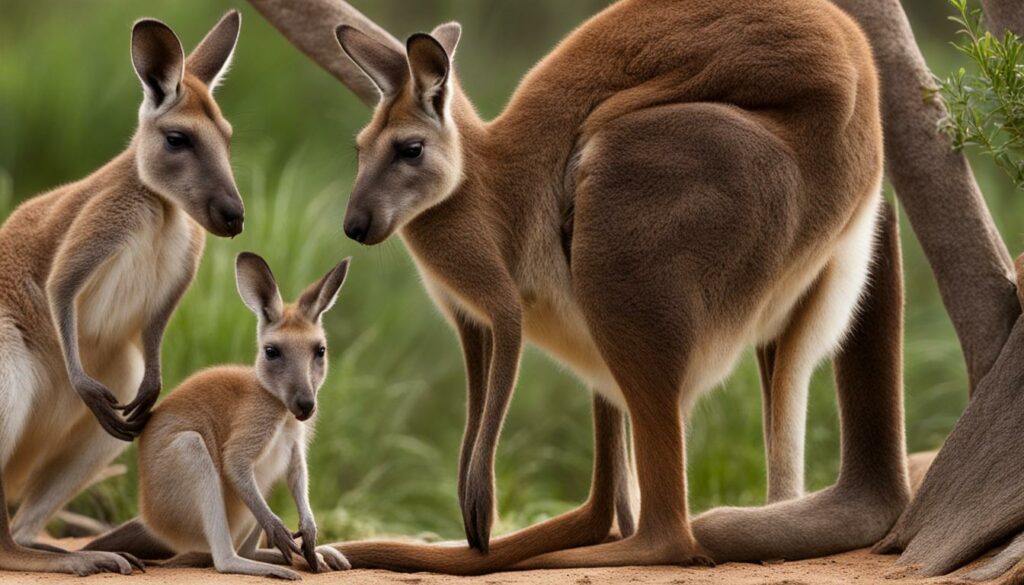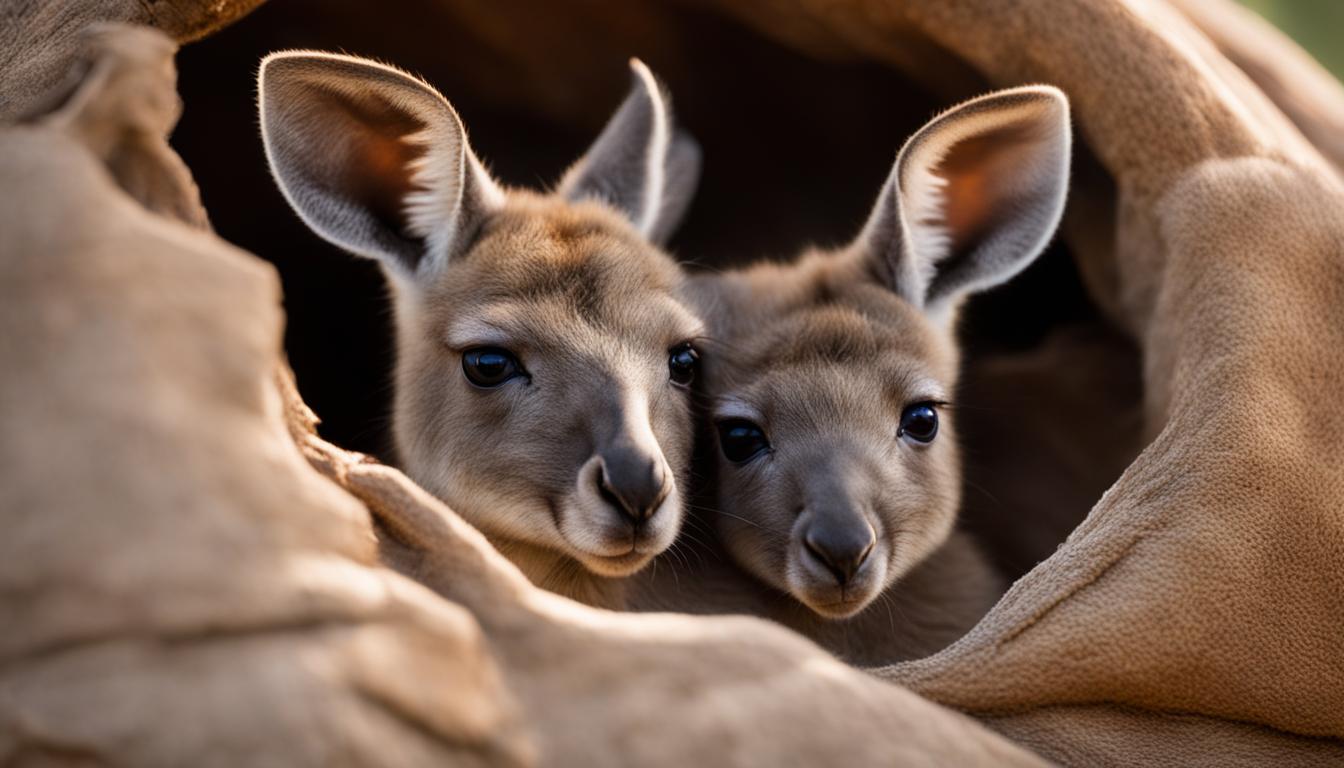Have you ever wondered about the fascinating function of a kangaroo’s pouch? This unique feature serves a crucial role in nurturing their young, known as joeys. Let’s dive into the details to uncover the wonders of the kangaroo pouch!
Anatomy of a kangaroo’s pouch
The kangaroo’s pouch is a fascinating and unique feature that sets it apart from other animals. Let’s take a closer look at the anatomy and characteristics of this incredible pouch.
The kangaroo’s pouch is essentially a fold of skin on the mother’s abdomen. It is made up of the mother’s skin, which is hairless on the inside. The pouch functions as a safe haven and a nurturing environment for the developing joey. Inside the pouch, there are four teats, which the joey latches onto for nourishment.
The pouch is warm and maintains the same temperature as the mother’s body, providing a cozy and comforting space for the young joey. It is soft and comparable to the skin on the inside of a person’s wrist. The pouch can open up quite a bit if the mother wants it to, providing ample space for the joey to grow and develop.
To understand the anatomy of a kangaroo’s pouch better, let’s look at the following table:
| Characteristics | Description |
|---|---|
| Location | On the mother’s abdomen |
| Composition | Fold of skin, hairless inside |
| Teats | Four teats for joey nourishment |
| Temperature | Maintains the same temperature as the mother’s body |
| Texture | Soft and comparable to the skin on the inside of a person’s wrist |
The kangaroo’s pouch is a remarkable adaptation that allows for the survival and development of their offspring. It is a warm and nurturing environment where the young joey can grow and thrive until it is ready to explore the world outside.
Evolution and Adaptation of the Kangaroo Pouch
The kangaroo pouch is a remarkable adaptation that has evolved in marsupials, including kangaroos. Marsupials, as a whole, have developed pouches to carry their young and provide them with a nurturing environment. The pouch likely originated as a simple fold of skin to protect the helpless young while they suckled. Over time, the pouch evolved into more complex structures that allow mothers to carry their dependent young with them at all times.

The pouch system in kangaroos and other marsupials is a unique adaptation that ensures the survival and development of their offspring. It provides a warm and secure environment for the young to grow and develop. The inside of the pouch is hairless and soft, providing comfort and protection. The pouch contains teats or milk ducts, providing nourishment to the young. This adaptation allows marsupials to have shorter gestation periods and give birth to underdeveloped young, providing them with the opportunity to continue developing externally.
The Evolution of Pouches in Marsupials
The evolution of pouches in marsupials is a fascinating example of how animals adapt to ensure the survival of their species. As marsupials evolved, the pouch became an increasingly important structure for carrying and protecting their young. The pouch allowed marsupials to have more mobile and independent offspring, as they could continue developing outside of the womb.
“The pouch system in kangaroos and other marsupials is a unique adaptation that ensures the survival and development of their offspring.”
Through millions of years of evolution, marsupials have perfected the design and function of their pouches. Each species of marsupial has its own unique type of pouch, tailored to suit its specific needs. Some pouches are forward-facing, while others are rear-facing. Some have a single opening, while others have multiple openings. These variations in pouch design are a testament to the adaptability and versatility of marsupials.
Adaptation for Survival
The kangaroo pouch and other marsupial pouches have played a crucial role in the survival and success of these unique animals. The pouch provides a safe and nurturing environment for the young to develop, allowing them to grow and thrive in a protected space. It also allows the mother to carry her young with her at all times, keeping them close for nourishment and protection.
The pouch has proven to be an advantageous adaptation for marsupials, as it increases their chances of survival in challenging environments. The ability to carry their young with them allows marsupials to keep their offspring safe from predators and from adverse environmental conditions. It also enables them to continue their own daily activities while ensuring the well-being of their young.
Other Marsupials with Pouches
While kangaroos are the most well-known marsupials with pouches, they are not the only ones. There are several other marsupials that also have pouches, each with their own unique characteristics and adaptations. These pouches play a crucial role in the reproduction and development of these animals, providing a safe and nurturing environment for their young.
One example of another marsupial with a pouch is the opossum. Opossums have a pouch similar to kangaroos, where their young crawl into after birth. Another example is the Tasmanian devil, which has a backward-facing pouch to protect its young while traveling. Koalas also have a pouch, although it is much smaller and less developed compared to kangaroos. Finally, wombats have a backward-facing pouch as well, which helps to keep dirt and debris out while they burrow.
“Other marsupials, including opossums, Tasmanian devils, koalas, and wombats, also raise their young in pouches.”
| Marsupial | Characteristics |
|---|---|
| Opossum | Have a pouch similar to kangaroos |
| Tasmanian devil | Backward-facing pouch for protection |
| Koala | Smaller and less developed pouch |
| Wombat | Backward-facing pouch to keep dirt out |
In conclusion, the pouch is not exclusive to kangaroos, but is a common feature among marsupials. These pouches provide a nurturing environment for the young to develop and grow, ensuring their survival and well-being. Each marsupial species may have slight variations in the structure and function of their pouches, but the underlying purpose remains the same – to protect and care for their offspring.
Reproduction and Development in Marsupials
Marsupials have a unique reproductive process compared to other mammals. Unlike placental mammals, marsupials have a shorter gestation period and give birth to undeveloped young. This early-stage birth allows the offspring to crawl into the mother’s pouch, where they continue to develop and grow. The pouch provides a warm and nurturing environment for the young to receive nourishment and protection.
The reproductive strategy of marsupials ensures that the young can continue developing externally while receiving essential care from their mother. They latch onto the teats inside the pouch and receive milk for nourishment. This process allows the mother to provide individualized care to each joey, ensuring their survival and growth.
The pouch plays a crucial role in the development of marsupials. It offers a safe space for the young to grow and develop their physical and cognitive abilities. Inside the pouch, the young are protected from predators and harsh environmental conditions. As they mature, they gradually venture out of the pouch and explore the world around them, but they may still return to the pouch for safety and comfort.
| Marsupial Reproduction Facts |
|---|
| Marsupials have a shorter gestation period compared to placental mammals. |
| The offspring are born at an early stage of development and crawl into the mother’s pouch. |
| The young latch onto teats inside the pouch for nourishment. |
| The pouch provides a warm and nurturing environment for the young to grow and develop. |
Overall, the reproduction and development process in marsupials showcases the remarkable adaptability and survival strategies of these unique creatures. The pouch serves as a remarkable feature that allows marsupials to give birth to undeveloped young while providing them with essential care and protection. This reproductive strategy has enabled marsupials to thrive and diversify in various environments around the world.
Pouches in Other Animals
The kangaroo’s pouch is undoubtedly fascinating, but did you know that pouches are not exclusive to marsupials? While marsupials are famous for their unique and specialized pouches, there are other animals that have evolved similar structures to serve specific purposes.
One intriguing example is the water opossum. This semi-aquatic freshwater species possesses a pouch with a strong sphincter muscle around the opening, which can be tightened to create a watertight seal. Interestingly, male water opossums also have a pouch, but instead of carrying young, it serves to protect their genitals while diving.
“Pouches are not exclusive to marsupials. The water opossum demonstrates that other animals have evolved pouch-like structures to serve specific purposes.”
While the evolution of pouches is most commonly associated with marsupials, the presence of pouches in non-marsupial animals emphasizes the diverse and remarkable ways in which nature adapts and thrives. It serves as a testament to the ingenuity and resourcefulness of different species in finding solutions to the challenges they face.
Pouches in Other Animals
While marsupials may be the most well-known animals with pouches, it’s fascinating to discover the lesser-known instances of pouches in other species. This highlights the versatility and adaptability of different animals in meeting the unique demands of their environments and lifestyles.
The importance of the pouch for marsupials
The pouch is a crucial feature for marsupials, serving as a nurturing and protective environment for their young. It plays a vital role in the development and survival of marsupial offspring, providing warmth, nourishment, and security.
Inside the pouch, the young continue to grow and develop, receiving the essential nutrients they need from their mother. The pouch maintains a constant temperature, mimicking the warmth of the mother’s body, ensuring optimal conditions for the young to thrive.
Furthermore, the pouch offers a safe space for the young to develop their physical and cognitive abilities. It allows them to gradually explore the outside world while still having the comfort and security of their mother’s presence.
The pouch is a remarkable adaptation that has evolved in marsupials over time. It enables marsupials to have a unique reproductive strategy, with shorter gestation periods and undeveloped young born at an early stage. Without the pouch, the survival and development of marsupial offspring would be significantly more challenging.
| Marsupial | Pouch Description |
|---|---|
| Kangaroo | Large, muscular, and opens towards the rear |
| Koala | Back-opening pouch that sits in the center of the abdomen |
| Tasmanian devil | Front-opening pouch with well-developed muscle control |
Marsupials, such as kangaroos, koalas, and Tasmanian devils, all rely on the pouch to provide the necessary care and protection for their young. Each species may have slight variations in the structure and function of their pouch, but the underlying purpose remains the same – to ensure the survival and well-being of their offspring.
Conclusion
The kangaroo’s pouch, along with pouches in other marsupials, offers numerous benefits for their reproductive and nurturing strategies. These pouches provide a unique and nurturing environment for the young to develop and grow before venturing out into the world.
The kangaroo’s pouch offers warmth, nourishment, and protection, ensuring the survival and well-being of the offspring. It is a remarkable adaptation that reflects the incredible diversity and complexity of nature’s reproductive strategies.
The evolution and adaptation of pouches in marsupials, such as kangaroos, showcase the ingenuity of nature in overcoming the challenges of parenting and reproduction. With their pouches, marsupials have devised an effective solution to support the growth and development of their young.
How do kangaroos use their pouch for communication or sound production?
Kangaroos use their pouch for a range of purposes, including communication. The pouch amplifies the sound of joeys, allowing them to chirp loudly to their mothers while inside. This is just one of the unique kangaroo communication methods that play a crucial role in their social interactions.
FAQ
What is the function of a kangaroo’s pouch?
The kangaroo’s pouch serves as a unique and essential feature for nurturing joeys. It provides warmth, nourishment, and protection for the developing young.
What is the anatomy of a kangaroo’s pouch?
The kangaroo’s pouch is essentially a fold of hairless skin on the mother’s abdomen. It contains four teats for the joey to latch onto and is soft and warm, maintaining the same temperature as the mother’s body.
How has the kangaroo pouch evolved and adapted?
The kangaroo pouch likely originated as a simple fold of skin to protect the young while they suckled. Over time, it evolved into a more complex structure, allowing mothers to carry their young with them at all times.
Are there other marsupials with pouches?
Yes, other marsupials such as opossums, Tasmanian devils, koalas, and wombats also raise their young in pouches. Pouches are a hallmark feature of marsupials.
How do marsupials reproduce and develop?
Marsupials have a shorter gestation period and give birth to undeveloped young. The young crawl into the pouch, latch onto teats, and continue to grow and develop until they are ready to emerge.
Are there pouches in other animals?
Yes, one example is the water opossum, which has a pouch that can form a watertight seal. While pouches are most commonly associated with marsupials, other animals have evolved pouch-like structures for specific purposes.
What is the importance of the pouch for marsupials?
The pouch is crucial for marsupials as it provides a nurturing environment for the young to develop and grow. Without the pouch, the survival of marsupial offspring would be much more challenging.
What are the benefits of a kangaroo’s pouch?
The kangaroo’s pouch provides warmth, nourishment, and protection for the developing joey. It allows the young to grow and develop before venturing out into the world.










